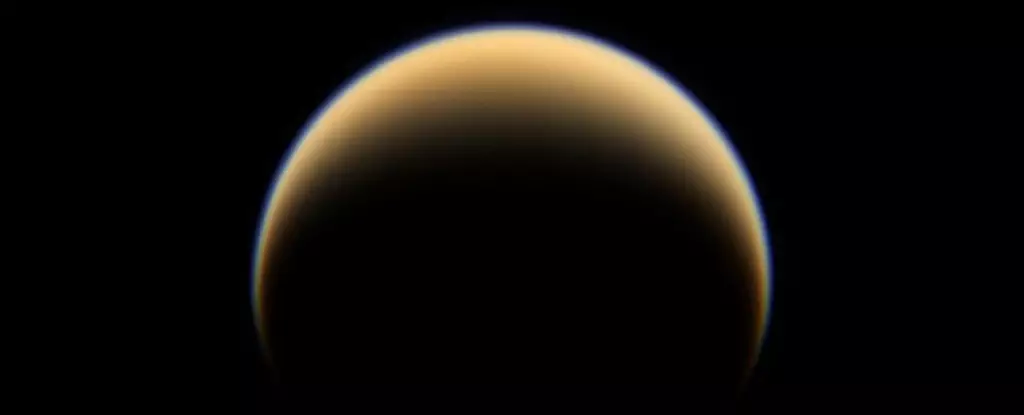Titan, Saturn’s colossal moon, has long captivated scientists and space enthusiasts as a prime candidate in the search for extraterrestrial life within our solar system. Its thick atmosphere, organic-rich surface, and suspected underground ocean form an intriguing environment where life might conceivably exist, despite the extreme conditions. However, recent research sheds a sobering light on just how tenuous this prospect might be, challenging our notions of what constitutes livable biomes far from Earth. While the allure of discovering alien life remains strong, the bleak reality underscores our current technological and biological limitations.
The moon’s internal structure resembles layered cake, with a rocky core ensconced in high-pressure ice, topped by a salty water ocean, itself covered by a thick ice crust. This stratification is not just a geological curiosity; it forms the foundation for understanding Titan’s potential habitability. The surface, adorned by hydrocarbon lakes and organic-rich rain, might serve as a conduit for nutrients and energy to seep into the hidden ocean below. Despite this, the key question is whether enough energy and nutrients are available to sustain even the simplest microbial processes.
Organic Molecules: The Building Blocks on the Brink of Sustainability
Titan’s atmosphere is a natural chemical factory. UV radiation breaks apart nitrogen and methane gases, leading to the synthesis of complex organic molecules, some of which are analogous to amino acids like glycine. These molecules descend through organic-rich aerosols and settle onto Titan’s surface, gradually migrating into the subsurface ocean through impact melt pools and cryovolcanic activity. Over geologic timescales, this influx of organics has accumulated, but the question remains: is this accumulation enough to support life? According to recent models, the quantity and energy available for sustaining microorganisms are remarkably limited.
This scarcity of energy is fundamental. While Earth’s biosphere thrives on abundant energy sources such as sunlight and oxygen, Titan’s environment lacks these luxuries. Instead, it depends on a process akin to fermentation—a form of anaerobic respiration—where microbes break down organic molecules without oxygen. This process is ancient, proven, and fundamental to life in extreme environments on Earth, which gives hope that, even in Titan’s harsh conditions, life may have found a way to persist, albeit in minuscule amounts.
The Stark Reality of Titan’s Microscopic Ecosystem
Recent bioenergetic modeling estimates that Titan’s entire underground biosphere could be comparable in mass to a small domestic dog—roughly a few kilograms spread across an immense ocean. At base level, the microbial population might be less than one cell per metric ton of water. To visualize this, it is akin to searching for a needle in an Earth-sized haystack—except the haystack is now a distant moon 800 million miles away.
Such an insignificant biomass raises profound questions about the viability and longevity of life in extraterrestrial oceans. The energy yield from organic molecules like glycine would be minimal, supporting only a handful of dormant or slow-growing microorganisms. This biological sparsity implies that chances of detecting living cells through current or even foreseeable technology are vanishingly small. It fundamentally challenges the optimistic notions held by some scientists that alien life on Titan could be abundant or detectable with existing instrumentation.
Challenging Our Expectations of Extraterrestrial Life
The implications of this research go beyond simple calculations; they question the very criteria we use to define habitability. Life on Earth is prolific because of abundant solar energy, liquid water, and a rich chemical environment. Titan offers none of these in abundance. Instead, we must reconcile ourselves to the fact that life, if it exists there, may be both exceedingly rare and remarkably fragile.
This realization should prompt a reassessment of how we pursue extraterrestrial biosignatures. Instead of searching for vast, Earth-like ecosystems, perhaps our efforts need to focus on detecting the faintest signs of life—microbial footprints, chemical disequilibria, or specific bio-signatures that can surface through indirect means. Titan’s ecosystem might be a microscopic, almost ghostly remnant of life struggling to sustain itself amid a universe that is largely inhospitable to such fragile organisms.
Reflections on Human Curiosity and Scientific Limits
Our fascination with worlds like Titan is rooted in a deep-seated hope that life is a universal phenomenon. Yet, this research underscores a sobering truth: the universe may be richer in inorganic complexity than in biological abundance. Titan’s icy depths, despite promising chemistry, might be the ultimate testament to the cold, indifferent universe—a reminder that life’s existence is both rare and delicate.
While this is a moment for humility and realistic assessment in our quest for alien life, it also accentuates the importance of perseverance. Each discovery, whether of abundant or scarce life, deepens our understanding of the cosmic conditions that can support or hinder living organisms. If Titan’s biosphere is just a whisper of life, then perhaps the universe is still waiting for the conditions that amplify that whisper into a chorus of thriving ecosystems. Meanwhile, scientists must grapple with nature’s limits and expand our technological horizons to detect even the faintest signs of life in the most unlikely places.

